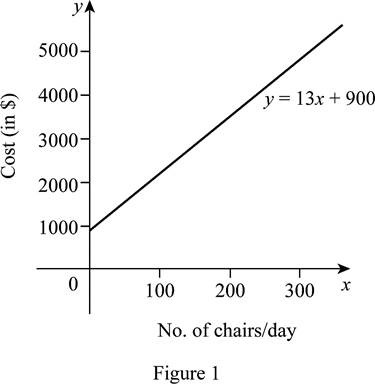
Concept explainers
(a)
To express: The cost in terms of the number of produced chairs and sketch the graph of the cost function.
(a)
Answer to Problem 16E
The equation of the temperature in terms of the number of chirps per minute N is
Explanation of Solution
Let x axis be represented the number of chairs per day and y axis be represented the manufacturing cost in dollars.
Recall the general equation of the linear function
Since the cost function follows the linear function, the equation of the cost y in terms of the number of produced chairs x is also in the form of
According to the given data, there are two points such as (100, 2200) and (300, 4800).
Obtain the slope m by using the two points.
Thus, the slope
Use the slope
Thus, the required equation is
The graph of cost function is shown below in Figure 1.

From Figure 1, it is observed that the graph is a straight line as the function is linear.
(b)
To find: The slope of the graph of the cost function and interpret it.
(b)
Answer to Problem 16E
The slope of the graph of the cost function is
Explanation of Solution
From part (a), the equation of cost as the function of number of chairs produced per day is
Since it follows a linear function, the coefficient of x is considered as slope.
Thus, the required slope is
Also, notice that the cost increases as the number of chairs produced per day increases as it follows the direct variation.
Observe that, if the number of produced chairs increases by 200, then the cost increases $2600. That is 13 chairs per dollar.
Therefore, the slope represents the rate of change of cost with respect to the number of chairs produced per day.
(c)
To find: The y-intercept of the graph of the cost function; interpret what it represent.
(c)
Answer to Problem 16E
The y-intercept of the graph of the cost function is 900. It represents the fixed manufacturing cost per day.
Explanation of Solution
The equation of cost as the function of number of chairs per day is
Since it follows a linear function, the constant term c is considered as y-intercept.
Thus, the y-intercept is
The y-intercept represents the fixed manufacturing cost per day.
Chapter 1 Solutions
Single Variable Calculus: Concepts and Contexts, Enhanced Edition
- Can you help explain what I did based on partial fractions decomposition?arrow_forwardSuppose that a particle moves along a straight line with velocity v (t) = 62t, where 0 < t <3 (v(t) in meters per second, t in seconds). Find the displacement d (t) at time t and the displacement up to t = 3. d(t) ds = ["v (s) da = { The displacement up to t = 3 is d(3)- meters.arrow_forwardLet f (x) = x², a 3, and b = = 4. Answer exactly. a. Find the average value fave of f between a and b. fave b. Find a point c where f (c) = fave. Enter only one of the possible values for c. c=arrow_forward
- please do Q3arrow_forwardUse the properties of logarithms, given that In(2) = 0.6931 and In(3) = 1.0986, to approximate the logarithm. Use a calculator to confirm your approximations. (Round your answers to four decimal places.) (a) In(0.75) (b) In(24) (c) In(18) 1 (d) In ≈ 2 72arrow_forwardFind the indefinite integral. (Remember the constant of integration.) √tan(8x) tan(8x) sec²(8x) dxarrow_forward
- Find the indefinite integral by making a change of variables. (Remember the constant of integration.) √(x+4) 4)√6-x dxarrow_forwarda -> f(x) = f(x) = [x] show that whether f is continuous function or not(by using theorem) Muslim_mathsarrow_forwardUse Green's Theorem to evaluate F. dr, where F = (√+4y, 2x + √√) and C consists of the arc of the curve y = 4x - x² from (0,0) to (4,0) and the line segment from (4,0) to (0,0).arrow_forward
 Calculus: Early TranscendentalsCalculusISBN:9781285741550Author:James StewartPublisher:Cengage Learning
Calculus: Early TranscendentalsCalculusISBN:9781285741550Author:James StewartPublisher:Cengage Learning Thomas' Calculus (14th Edition)CalculusISBN:9780134438986Author:Joel R. Hass, Christopher E. Heil, Maurice D. WeirPublisher:PEARSON
Thomas' Calculus (14th Edition)CalculusISBN:9780134438986Author:Joel R. Hass, Christopher E. Heil, Maurice D. WeirPublisher:PEARSON Calculus: Early Transcendentals (3rd Edition)CalculusISBN:9780134763644Author:William L. Briggs, Lyle Cochran, Bernard Gillett, Eric SchulzPublisher:PEARSON
Calculus: Early Transcendentals (3rd Edition)CalculusISBN:9780134763644Author:William L. Briggs, Lyle Cochran, Bernard Gillett, Eric SchulzPublisher:PEARSON Calculus: Early TranscendentalsCalculusISBN:9781319050740Author:Jon Rogawski, Colin Adams, Robert FranzosaPublisher:W. H. Freeman
Calculus: Early TranscendentalsCalculusISBN:9781319050740Author:Jon Rogawski, Colin Adams, Robert FranzosaPublisher:W. H. Freeman
 Calculus: Early Transcendental FunctionsCalculusISBN:9781337552516Author:Ron Larson, Bruce H. EdwardsPublisher:Cengage Learning
Calculus: Early Transcendental FunctionsCalculusISBN:9781337552516Author:Ron Larson, Bruce H. EdwardsPublisher:Cengage Learning





